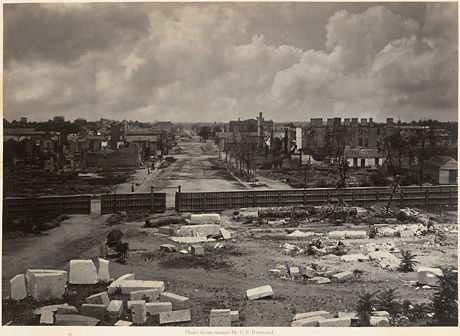Document or Art? Photography in the Long 19th Century, 1839-1914
Friday October 17, 2008 - Sunday December 7, 2008
George N. Barnard (American, 1819-1902), Columbia from the Capitol from Photographic Views of Sherman's Campaign, 1866, albumen print. Friends of the Davison Art Center funds, 1995.13.1 (photo: R. J. Phil)
In "The Salon of 1859," French critic Charles Baudelaire denounced photography as "art's most mortal enemy." Baudelaire argued that photographs could provide factual records, but he reserved the realm of art for painting and other products of the imagination. At the same time, however, photographers such as Oscar G. Rejlander carefully composed and combined negatives to assert their skill as artists. Over the course of the long 19th century, the debate over the nature and use of photography continued, as photographers explored the technical and artistic possibilities of the evolving medium.
This exhibition explored shifting uses and interpretations of photographs from the announcements in 1839 about competing inventions by Louis Jacques Mandé Daguerre and William Henry Fox Talbot to the outbreak of World War I in 1914. Selected from the Davison Art Center collection, the show highlighted works by Thomas Annan, Julia Margaret Cameron, Francis Frith, Alexander Gardner, Eadweard Muybridge, Jacob Riis, Alfred Stieglitz, Carleton Watkins, and many more.
From the invention of photography in 1839 to 1914, photographers documented the American Civil War, the American West, and urban poverty. They also created narratives and promoted the aesthetic opportunities of the new medium. Document or art? In the 19th century, a photograph could be either or both.
Caption for home page image: Carleton Watkins (American, 1829-1916), Glacier Point, 3,257 feet, Yosemite, California, ca. 1868-70, printed after 1874 by I. W. Taber, albumen print. Weedon Endowment and Friends of the Davison Art Center funds in honor of Juana Maria G. Flagg, 1982.43.1 (photo: R. J. Phil)
This exhibition was presented as part of Eye of History: The Camera as Witness, a Wesleyan University series of exhibitions, talks, and films that explored questions about photography and its role in historiography, historical memory, and public life.